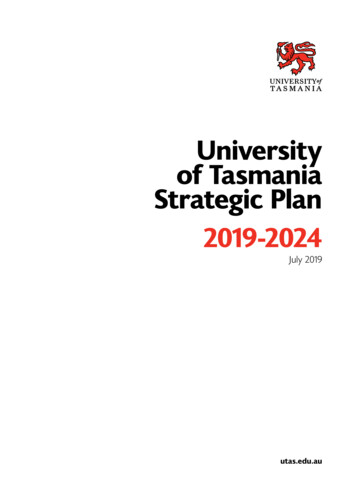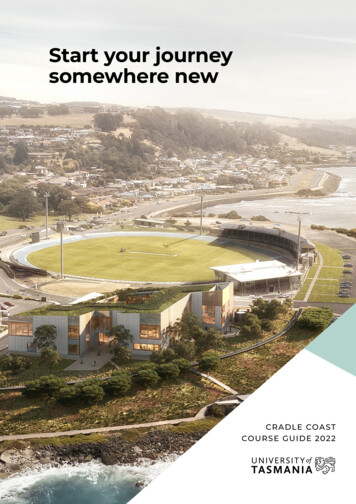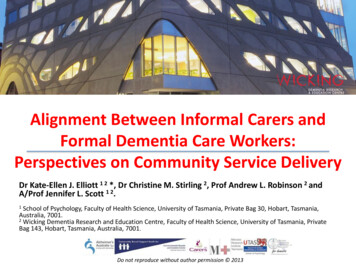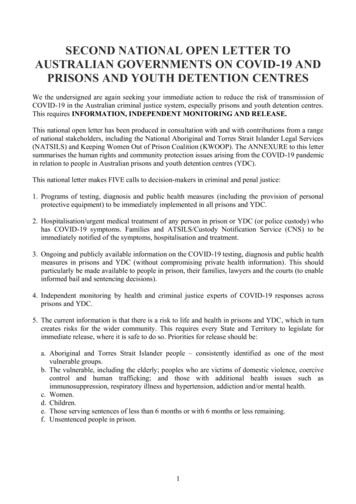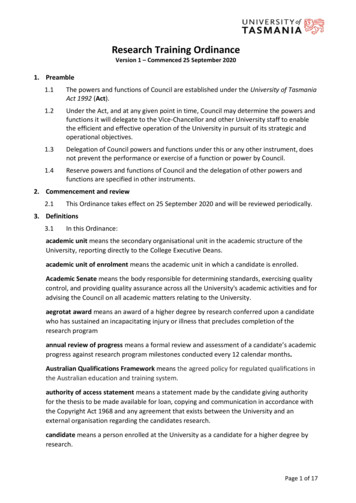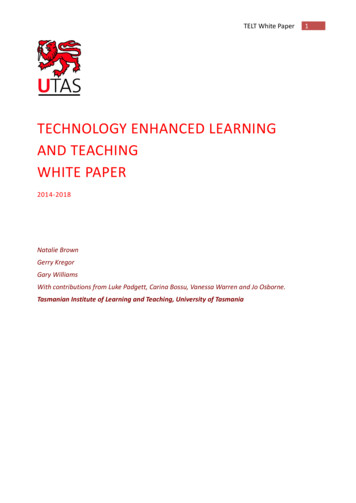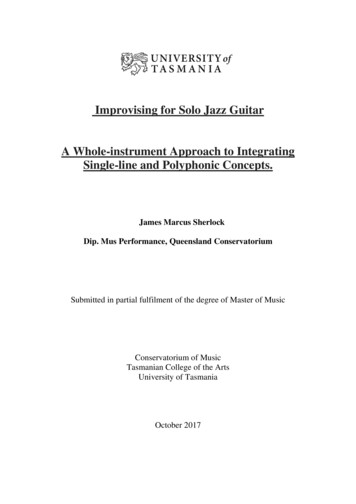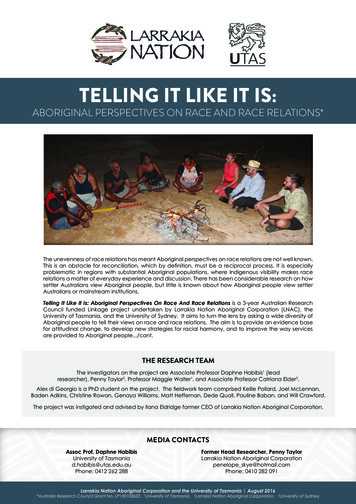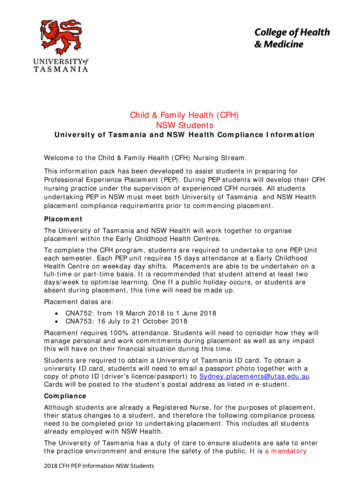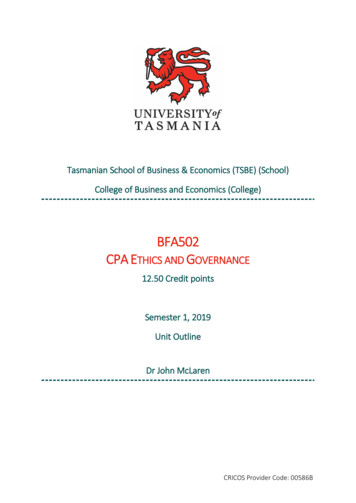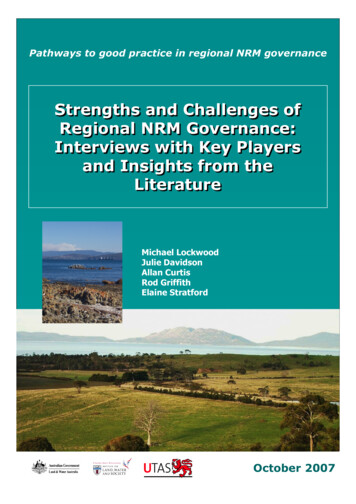
Transcription
!"##
STRENGTHS AND CHALLENGES OFREGIONAL NRM GOVERNANCE:INTERVIEWS WITH KEY PLAYERS ANDINSIGHTS FROM THE LITERATUREMichael LockwoodJulie DavidsonAllan CurtisRod GriffithElaine StratfordOCTOBER 2007REPORT NO. 4OF THE PROJECTPathways to good practice in regional NRM governance
Pathways to good practice in regional NRM governanceProject overviewEnvironmental degradation, including biodiversity loss and water quality decline, is a major problem facingAustralia. Regional delivery of natural resource management (NRM) is the main mechanism for addressingsuch issues. Yet we lack fundamental understandings about the effectiveness and quality of regional NRMgovernance. Governance involves consideration of issues such as authority, accountability, representation,and consultation. It is a key determinant of the capacity of regional NRM institutions to make effectivedecisions and deliver outcomes. This interdisciplinary and collaborative project was conceived to assess theeffectiveness of regional NRM governance and to develop a standard for good-practice NRM governance.The work focuses on nine NRM regions in NSW, Victoria and Tasmania. The objectives are to:1.2.3.4.5.6.establish a theoretically robust understanding of good regional NRM governance;develop a set of principles for good regional NRM governance;describe regional NRM governance arrangements and structures, with particular reference to our ninepartner regions;assess the quality of NRM governance in our nine partner regions, as well as the state and nationallevels, against our governance principles and related themes;identify aspects of regional NRM governance in our nine partner regions as well as the state andnational levels, that should be targeted for improvement, anddevelop a standard for good regional NRM governance that can be used to benchmark and trackgovernance performance.Principal FundingLand and Water AustraliaPrincipal ResearchersMichael Lockwood (School of Geography & Environmental Studies, University of Tasmania)Allan Curtis (Institute for Land, Water & Society, Charles Sturt University)Elaine Stratford (School of Geography & Environmental Studies, University of Tasmania)Research FellowsJulie Davidson (School of Geography & Environmental Studies, University of Tasmania)Rod Griffith (Institute for Land, Water & Society, Charles Sturt University)Regional PartnersDon Forsyth, Peter Codd (Corangamite CMA)Gavin Hanlon, Chris Hain (North Central CMA)Bill O’Kane, Megan McFarlane (Goulburn Broken)Anthony Couroupis, Emmo Willinck (Murray CMA)Chris Glennon, Kate Lorimer-Ward (Lachlan CMA)Tim Ferraro (Central West CMA)Michael Pitt (Northern Rivers CMA)David McCormack (Cradle Coast NRM)Vanessa Elwell-Gavins (NRM South)State Government PartnersPeter Andrew (DSE, Victoria)Tom Grosskopf, Jim Booth (DECC, NSW)Alan Haig, John Whittington (DPIW, Tasmania)Australian Government PartnersPeter Creaser, Debbie Langford, Beth Cameron(Australian Government NRM)Land and Water AustraliaNoel Beynon, Tracy HendersonCatherine Murdoch and the NRM North team have assisted in piloting research instruments and project outputs.For information about the project, please contact Dr Julie Davidson, School of Geography &Environmental Studies, University of Tasmania, (03) 6226 7675, Julie.Davidson@utas.edu.auISBN: 978-1-86295-422-9Previous reports in this seriesDavidson, J. Lockwood, M., Curtis, A., Stratford, E. Griffith, R. (2006) Governance principles for regionalnatural resource management. Report No 1 of the project “Pathways to good practice in regional NRMgovernance”. University of Tasmania, Hobart.Davidson, J. Lockwood, M., Curtis, A., Stratford, E. Griffith, R. (2007) NRM governance in Australia:NRM programs and governance structures. Report No 2 of the project “Pathways to good practice inregional NRM governance”. University of Tasmania, Hobart.Stratford, E., Davidson, J., Lockwood, M., Griffith, R., Curtis, A. (2007) Sustainable development andgood governance: the ‘big ideas' influencing Australian NRM. Report No 3 of the project “Pathways togood practice in regional NRM governance”. University of Tasmania, Hobart.Copies of these reports are available from: www.geog.utas.edu.au/geography/nrmgovernance/Cover photographs: Tasmanian East Coast (courtesy Kerry Bridle), Derwent Estuary (courtesy Ian Sansom).
CONTENTSABBREVIATIONSiiACKNOWLEDGEMENTSiiEXECUTIVE SUMMARYiii1. INTRODUCTION12. METHODOLOGY33. RESULTS OF PARTICIPANT INTERVIEWS54. VIEWS FROM THE LITERATURE385. SYNTHESIS OF INTERVIEW DATA AND THE LITERATURE476. CONCLUSION7. REFERENCESAPPENDIX 1. INTERVIEW SCHEDULE535759LIST OF TABLESTable 1. Number of text blocks per principle, by respondent group5Table 2. Standardised percentage text blocks per principle,by respondent group (those above 3% highlighted)5i
SEGB CMAGMWICICACIP3JSCMERMOUMSSNAPNC CMANHTNRCNRMPPARCIPRCSRICCatchment Action GroupCatchment Action PlanCorangamite Catchment Management AuthorityChief Executive OfficerCatchment Management AuthorityCatchment Management BoardCatchment Management CommitteeDepartment of Environment and Climate Change (NSW)Department of Natural Resources (NSW)Department of Primary Industry (Victoria)Department of Primary Industry and Water (Tasmania)Department of Sustainability and Environment (Victoria)Goulburn Broken Catchment Management AuthorityGoulburn-Murray WaterImplementation CommitteeIndependent Commission Against CorruptionInvestment Plan 3Joint Steering CommitteeMonitoring, Evaluation and ReviewMemorandum of UnderstandingMunicipal Strategic StatementsNational Action Plan for Salinity and Water QualityNorth Central Catchment Management AuthorityNatural Heritage TrustNatural Resources CommissionNatural Resource ManagementPest Plant and AnimalsRegional Catchment Investment PlanResource Condition StrategyRegional Investment CommitteeAcknowledgementsThe research team would like to acknowledge the outstanding contributions from the 55participants who participated in interviews. We also thank Sonja Van Hoof for organisingthe interview sessions, and Kristin Warr for tidying up some of the editorial details. Weparticularly thank the contact representatives of our nine partner NRM regional bodies,Department of Sustainability and Environment (Victoria) and Department ofEnvironment and Climate Change (NSW), and the Australian Government NRM team –these people are listed on the inside front cover of this report. We also benefited fromadditional verbal and written comment offered by other government agency staff.This research was funded by a Social and Institutional Research Programme grant fromLand & Water Australia. The Department of Sustainability and Environment (Victoria)and Department of Environment and Climate Change (NSW) also made financialcontributions to the project.ii
EXECUTIVE SUMMARYThe work presented in this report is an outcome from the Land & Water Australia fundedproject Pathways to good practice in regional NRM governance. This interdisciplinaryand collaborative project was conceived to assess the effectiveness of regional naturalresource management (NRM) governance and to develop a standard for good-practiceNRM governance. The work is focussed on nine regions across Tasmania (Cradle Coast,South), Victoria (Corangamite, North Central, Goulburn Broken) and NSW (CentralWest, Murray, Lachlan, Northern Rivers), as well as the state jurisdictions of NSW,Victoria and Tasmania and the national level.In this report, we assess the strengths and challenges of NRM governance in our ninepartner regions, as well as the state and national levels, against eight governanceprinciples and related themes. We undertake this task using (i) 55 interviews with keyplayers from our partner regions, and associated government jurisdictions; and (ii) areview of the related literature. We synthesise our empirical data with insights from theliterature and analyse the common ground and discrepancies between them. From this,we reach the following conclusions about the current strengths and challenges of NRMgovernance. Note that these conclusions principally apply to the nine partner regions andrelated state jurisdictions, as well as certain aspects of Australian Governmentinvolvement in the system. We do not make any claims about their applicability to the 47other regional NRM bodies and other state and territory jurisdictions.1. The legitimacy of the regional NRM system is moderate. Regional NRM bodies are faced with managing tensions between legitimacyconferred on them by governments, and a perceived need to be recognised asseparate from government in order to earn legitimacy from their communities. Autonomy is a real concern as a result of insufficient devolution of powers toregional NRM bodies by the Australian and some state governments. Equally,regional NRM bodies need to recognise and respect the legitimacy ofgovernments’ roles in the multilayer NRM governance system. Greater devolution should not exempt governments representing extra-regionalinterests or addressing national and international concerns and obligations. Personal integrity of the key players appears sound, with the commitment ofregional decision makers and some stakeholders, a key strength. Processes and responses to ‘conflict of interest’ issues are sound, and probityrelated matters are being effectively managed through codes of practice andtraining. Questions linger over the genuineness of some governments’ commitment toNRM.2. The transparency of regional NRM bodies is strong. A range of communication and reporting media is used, often targeted toparticular audiences and needs. Regions that are less mature or relatively resource-poor recognise a need forimprovement.iii
3. The accountability of the regional NRM system is moderate. Upward accountability of regional NRM bodies to government is well establishedand continues to be strengthened. Reporting requirements imposed by governments are generally perceived to beunnecessarily complex and demanding. Role clarity is a key accountability weakness, both at a systems level and forparticular NRM activities (water, native vegetation and pest plant and animalmanagement). Clarification of roles, responsibilities and accountabilities is needed (i) for allorganizations involved in Australian NRM; and (ii) on the status and functions ofthe various strategic plans and operational instruments. Downward accountability of regional NRM bodies to their communities isrequired for democratic NRM governance, suggesting a need to continuestrengthening earned legitimacy and inclusive governance practices.4. The inclusiveness of the regional NRM system is moderate. All participants are strongly committed to inclusive governance, which isconsidered by some regions to be a strength of the system. Establishing effective engagement with several key stakeholders – Indigenouscommunities, ‘care’ groups, local governments, agribusiness, urban andenvironmental constituencies – remains a significant challenge. Engagement of regional actors in higher-level processes is currently inadequate –inclusion of regional NRM representatives in higher-level coordination anddecision-making is a desirable governance reform. Wider societal and environmental concerns tend to be under-represented at theregional level – this demands a strengthening of the system as a whole, as it is atthe state and national levels where such concerns are best represented andpursued.5. The fairness of regional NRM bodies is moderate to strong. Decision-making procedures generally ensure consistency and absence of bias indecision-making. The tension between a strategic approach and the disproportionate allocation ofNRM benefits across areas and sectors remains a concern. The use of formal procedures to track, justify and communicate the distribution ofcosts and benefits arising from NRM decisions is desirable. More effective conflict management would improve governance fairness. Fostering a culture of mutual respect, active listening and honesty, where lack ofdistortion, manipulation and deception are the norm, would assist fairness.6. The integration of the regional NRM system is weak to moderate. Alignment of broad NRM direction across national, state and regional levelsgenerally appears sound. Inadequate vertical and horizontal connection and coordination is leading to suboptimal system-wide performance. Integration of NRM policy and action across national, state and regional levels ispatchy, and where present, often superficial.iv
National and state leadership is required to bring all the efforts into a coordinatedprogram that is delivering significant large-scale outcomes.Horizontal integration between CMAs is patchy, but strengthening, althoughcompetition between regions remains a barrier.Effective partnerships and projects between regional NRM bodies and with otherregional NRM providers are being developed.The tensions and contradictions of operating in a competitive businessenvironment and the imperative for partnership building are ongoing governancechallenges for regional NRM bodies.7. The capability of the regional NRM system is moderate to weak. Regional NRM bodies generally have well-established business systems, andthose that do have deficiencies are making it a priority to remedy theshortcomings. Board and staff members of regional NRM bodies are generally high calibre andexperienced, though remote and chronically under-resourced regions aredisadvantaged. The level of investment in NRM continues to produce a significant capabilitydeficit, but even more important is the manner in which funding is delivered andconstrained by governments – more durable and flexible funding arrangementsare needed. Knowledge management systems are generally of limited effectiveness and insome cases poorly developed – knowledge management is a major long-termchallenge for governments, research providers and regional NRM bodies.8. The adaptability of the regional NRM system is moderate to weak. System-level adaptability is made difficult by cumbersome and time consumingamendment processes, institutional fragmentation and related transboundaryissues, tensions between competing interests, and poorly integrated knowledgegeneration and management. Few regions have fully operational systems to make them learning organizations.State and national level processes are also under-developed. Current and emerging monitoring, evaluation and review systems adequatelyprovide for accountability but are insufficient to enable an operational adaptivemanagement capacity. Governments need to provide leadership in developing adaptive capability whileall organizations have to tackle current antagonistic cultural and institutionalconditions.While the governance weaknesses indicated above need to be acknowledged andaddressed, they do not constitute fatal flaws in the structure of the current multi-levelmodel of regional delivery. The overwhelming view of those interviewed, and one withwhich we concur, is that the regional model is generally sound and should be allowedtime to fulfil its potential. For this to occur, however, significant advances are required inaspects of system and regional level governance, particular those related to integration,capability and adaptability. In this regard, we note that there appears to be a high level ofcommitment to the regional NRM approach and a willingness to meet these challenges.v
vi
1. INTRODUCTIONThe work presented in this paper is an outcome from the Land & Water Australia fundedproject Pathways to good practice in regional NRM governance. This interdisciplinaryand collaborative project was conceived to assess the effectiveness of regional NRM(natural resource management) governance and to develop a standard for good-practiceNRM governance. The work is focussed on nine regions across Tasmania (Cradle Coast,South), Victoria (Corangamite, North Central, Goulburn Broken) and NSW (CentralWest, Murray, Lachlan, Northern Rivers), as well as the state jurisdictions of NSW,Victoria and Tasmania and the national level.The project objectives are to:1. establish a theoretically robust understanding of good regional NRM governance;2. develop a set of principles for good regional NRM governance;3. describe regional NRM governance arrangements and structures, with particularreference to our nine partner regions;4. assess the quality of NRM governance in our nine partner regions, as well as thestate and national levels, against our governance principles and related themes;5. identify aspects of regional NRM governance that should be targeted forimprovement in our nine partner regions as well as the state and national levels;and6. develop a standard for good regional NRM governance that can be used tobenchmark and track governance performance.This report addresses Objectives 4 and 5. It presents the outcomes from qualitativeinterviews that provide descriptive data on the quality of NRM governance in our ninepartner regions, as well as state and national levels. These data are organised according tothe governance principles developed in the project, as well as a number of subsidiarythemes. The development of the principles is described in Davidson et al. (2006).Since publication of this report, the principles therein have been further refined throughconsultation with our research partners and subsequent re-consideration by the researchteam. More details on the process used to develop the principles are given in Lockwoodet al. (2007). The eight principles are as follows:Principle 1. LegitimacyLegitimacy refers to (i) the validity of an organization’s authority to govern that may be(a) conferred by democratic statute; or (b) earned through the acceptance by stakeholdersof an organization’s authority to govern; and (ii) the integrity and commitment withwhich this authority is exercised.Principle 2. TransparencyTransparency refers to (i) the visibility of decision-making processes; (ii) the clarity withwhich the reasoning behind decisions is communicated; and (iii) the ready availability ofrelevant information about the governance and performance of an organization.1
Principle 3. AccountabilityAccountability refers to (i) the allocation and acceptance of responsibility for decisionsand actions; and (ii) the demonstration of how these responsibilities have been met.Principle 4. InclusivenessInclusiveness refers to the opportunities available for stakeholders to participate in andinfluence decision-making processes.Principle 5. FairnessFairness refers to (i) the respect and attention given to stakeholders’ views; (ii)consistency and absence of personal bias in decision-making; and (iii) the considerationgiven to distribution of costs and benefits of decisions.Principle 6. IntegrationIntegration refers to (i) the connection between, and coordination across, different levelsof government; (ii) the connection between, and coordination across, organizations at thesame level of governance; and (iii) the alignment of visions and strategic directionsacross governance organizations.Principle 7. CapabilityCapability refers to the systems, resources, skills, leadership, knowledge and experiencethat enable organizations, and the individuals who direct, manage and work for them, todeliver on their responsibilities.Principle 8. AdaptabilityAdaptability refers to (i) the incorporation of new knowledge and learning into decisionmaking and implementation; (ii) anticipation and management of threats, opportunitiesand associated risks; and (iii) systematic self-reflection on organizational performance.In the next section, we describe the method used to collect and analyse information frominterviews with our partners on the strengths and challenges of regional NRMgovernance. Results from the interviews are given in Section 3. In Section 4, we thenpresent a short review of the academic literature that has examined the Australianregional NRM experiment. A synthesis of our empirical data with insights from theliterature is given in Section 5, where we analyse the common ground and discrepanciesbetween the empirical and academic material. In Section 6, we offer conclusions aboutthe current strengths and weaknesses of NRM governance in our partner regions as wellas in the related state and national jurisdictions.2
2. METHODOLOGYData for Section 3 of this report were collected using a series of qualitative interviewsheld with representatives from our nine partner regions, as well as the state jurisdictionsof NSW, Victoria and Tasmania and the national level. Representatives from the boardand staff of the following regional NRM bodies were interviewed: Corangamite Catchment Management Authority (CMA);North Central CMA;Goulburn Broken CMA;Murray CMA;Lachlan CMA;Central West CMA;Northern Rivers CMA;Cradle Coast NRM; andNRM South.Interviews were also held with NRM staff from the NSW, Victorian, Tasmanian andAustralian Governments, as well as with an advisor operating at the national level. Theselection of participants, interview schedule and handling of data were approved by theUniversity of Tasmania Human Research Ethics Committee. Consistent with theapproved procedure, this report preserves the anonymity of participants. A total of 55participants were interviewed. Participants are referred to according to a code based onwhether they operate at regional, state or national levels and, if the regional level,whether they are a board member or staff of the regional NRM body. A numericalsubscript is used to indicate where more than one participant was interviewed from aparticular category. The participant codes are as follows: NB1 to NB8NS1 to NS11NG1VB1 to VB7VS1 to VS8VG1TB1 to TB7TS1 to TS6TG1 to TG2AG1 to AG3AA1NSW Regional Body BoardNSW Regional Body StaffNSW GovernmentVictorian Regional Body BoardVictorian Regional Body StaffVictorian GovernmentTasmanian Regional Body BoardTasmanian Regional Body or Regional Authority StaffTasmanian GovernmentAustralian GovernmentAustralian Advisor.Each interview was conducted by two members of the research team. One team memberasked the questions; the other took notes and recorded the session. Recordings were madeas a back-up. In the event, the notes were the only data form needed for the analysis.Draft transcripts were constructed from the notes, and sent to the participants forchecking. Several participants made amendments to the draft transcripts of theirinterviews. In these cases, a revised transcript was produced. Most interviews were withone participant, with several group interviews also conducted at the request of membersof the participating regions.3
The interview format and question schedule were pre-tested with the Tasmanian regionalbody, NRM North. As a result, minor adjustments were made to the order and timing ofthe sessions. The final interview schedule is given in Appendix 1.A content analysis of the interview transcripts proceeded as follows. The research teammet and, drawing on the overall experience of the interviews, developed a draft set ofthemes under each governance principle. One member of the interview team thenselected discrete text blocks from each transcript, each of which constituted a single pointbeing made by the participant. Each text block was then categorised under a principle andtheme. Blocks that were difficult to classify were grouped separately. Text blocks notrelated to the research objectives were not included. The initial classification waschecked by a second member of the interview team, and any differences resolved by theteam members. The result was a draft spreadsheet of classified text blocks, codedaccording to the corresponding participant.This draft spreadsheet was then re-analysed by two research team members, whoallocated a category to the unclassified text blocks, and resolved several inconsistenciesand inappropriate classifications. By this stage, the original set of principles had beenrevised, so the classification was updated to reflect the final eight principles listed inSection 1. During this process, some revisions were also made to the themes. Text blocksin the final spreadsheet under each principle and theme were then integrated andsummarised.The next section offers a summary of the content analysis, using example text blocks foreach principle and theme.4
3. RESULTS OF PARTICIPANT INTERVIEWSIn all, 1,059 text blocks were identified and classified, first by the principle most closelyrelated to the content of the block, and second by a keyword (theme) derived from thedefinitions of each principle given in Section 1. Before going into detail of thegovernance strengths and weaknesses associated with each principle, we first present anoverview of the emphases given to each principle by the participants, as indicated by therelative numbers of text blocks. Examining the breakdown of text blocks by respondentgroups (total and per-respondent) is also instructive. We then detail the content ofparticipants’ comments, organised according to each principle.Table 1 indicates the number of text blocks per principle, by respondent group.Comments regarding the capability, legitimacy and integration dimensions of governancepredominated. Inclusiveness, adaptability and transparency received a moderate level ofcommentary, while relatively few comments were made about accountability onTotalPercentageAccountabilityLegitimacyTable 1. Number of text blocks per principle, by respondent group1951824823113111059100NSW GovernmentVictorian RegionsVictorian Government1.72.3Tasmanian RegionsTasmanian Government2.6Australian Gov. & nclusiveness2.9TransparencyNSW RegionsAccountabilityRespondent GroupLegitimacyTable 2. Standardised percentage text blocks per principle, by respondent group(those above 3% highlighted)16.816.613.314.313.614.710.7100.0
Percentage responses for each respondent group, standardised to account for the relativenumbers of participants in each group, are given in Table 2. Some interesting differencesbetween groups are apparent. NSW government participants mainly made comment onlegitimacy, integration and transparency, while NSW regions were more concerned withcapability, as well as integration. Victorian government participants focussed onintegration, transparency and capability, while Victorian regions emphasised capability.Tasmanian government participants highlighted capability, integration and inclusiveness,while the regions spoke most about legitimacy, as well as capability. AustralianGovernment participants gave emphasis to the legitimacy dimension of governance. Thestate agency participants thus had a common emphasis on integration, and the regions hada common emphasis on capability. Transparency was also an important component forNSW and Victorian government participants.LegitimacyKeywords: commitment, conferred, earned, integrityTasmanian participants noted the relative immaturity of their institutions, and theconsequent need for strong long-term government support to allow the system to developits potential. There was a concern that if policy changes too rapidly, there is not theopportunity for such consolidation and maturation to occur, thereby threatening theachievement of outcomes. Tasmanian participants were also concerned about themismatch between government expectations and their level of support.Policy and institutional change was also raised in NSW, but with more emphasis on therelationship between these, durability and legitimacy: “durability and consistency givesyou legitimacy in the community” (NB2). The need for durability and on-goingcommitment from governments to earn legitimacy for the system was also noted inVictorian and NSW regions:We’ll come and go – CMC [Catchment Management Committee1], CMB[Catchment Management Board], CMA – CMZ might be next but we need toleave a legacy in the community. The community has to feel that they have a sayin it all because they are the ones who will make the difference. There will bedurability in the whole system (NB1).We are in an industry that is new, that takes a long-time to show results and weare into cultural change so we need a lot of consistent and persistent attention. Ifwe don't watch out we will be like the agencies in the past where there were lotsof reports that went nowhere. CMAs must insist on durability of policy and getthe government to understand that we have a 20 year time-frame (VB1).The conferred nature of regional NRM bodies’ legitimacy was a source of concern in thesense that the regional bodies themselves had no say in their own creation. Legislationwas also recognised as a two-edged sword. On the one hand it imparted an authority toregional planning and action in Victoria and NSW:1Squarebrackets are used to identify explanatory notes or interpolations made by the authors.6
Legitimacy: I see that as a strength. We have clear authority under certain Acts(VS1).The legislative base; and roles and responsibilities are clearly defined. As a resultthere is no ambiguity and a lot of stability as a result (NG1).On the other hand, it necessitated strategies that emphasise a separation from governmentin order to establish community (earned) legitimacy:It’s about building trust – the link with government is a constraint on the publicperception. The name ‘authority’ gives the community the wrong impression. Ourperception is that it is somewhere that they can get advice and informationwhereas they see us as a regulator, as the compliance organization but we call inthe DNR [the then Department of Natural Resources] to do the re
IP3 Investment Plan 3 JSC Joint Steering Committee MER Monitoring, Evaluation and Review MOU Memorandum of Understanding MSS Municipal Strategic Statements NAP National Action Plan for Salinity and Water Quality NC CMA North Central Catchment Management Authority NHT Natural Heritage Trust NRC Natural Resources Commission
